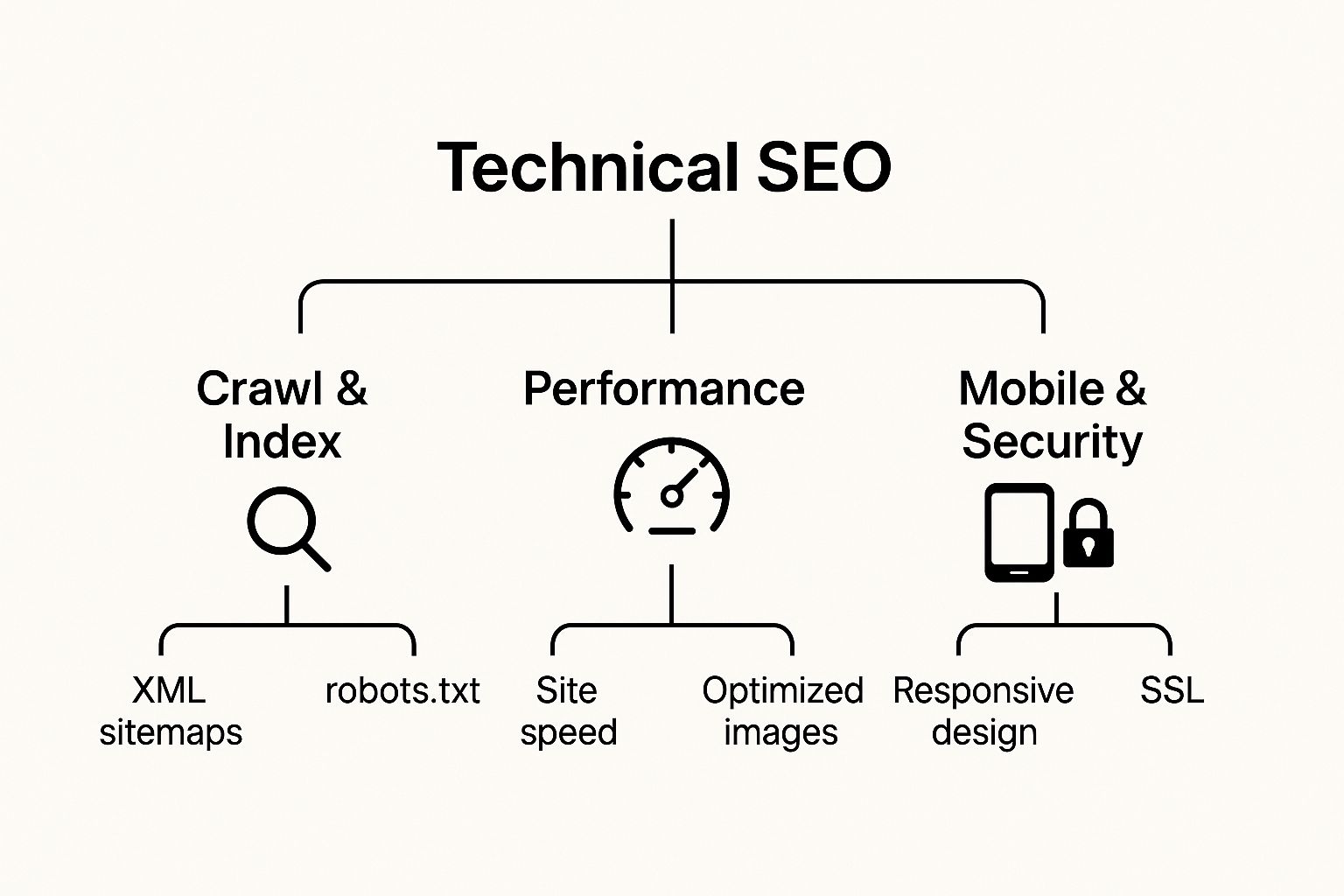What Is Technical SEO? A Simple Guide for Business Owners in 2025
Let's be honest, the term 'technical SEO' can sound a bit intimidating. It often brings up images of complex code and techy jargon that only a developer could possibly understand. But the truth is much simpler: it’s all about making sure your website is built in a way that search engines like Google can easily find, crawl, and understand your content.
Building Your Digital Storefront The Right Way
Imagine your website is a new shop you’re opening in Kelowna. You might have the best products in the entire Okanagan, but what if the doors are locked, the signs are confusing, and the aisles are a total mess? No one is going to stick around, let alone buy anything.
Technical SEO is all that crucial behind-the-scenes work. It’s about giving your digital storefront a solid foundation, a logical layout, and clear signage. This is the essential framework that allows all your other marketing efforts – like your brilliant content and beautiful design – to actually get seen and do their job.
Without a solid technical base, you’re practically invisible to the search engines that bring you new customers. It's a frustrating spot to be in, but one we see all the time.
The Three Pillars Of A Strong Website Foundation
So, what does this behind-the-scenes work actually look like? It really boils down to three core jobs: making sure search engines can find your site, making sure it's lightning-fast, and making sure it's secure and user-friendly for everyone.
This infographic gives a great visual breakdown of these core pillars.

As you can see, it all starts with the basics of helping Google discover and index your pages. From there, it moves into performance and security, which are things that directly impact how a real person feels when they land on your site.
To put it even more simply, here’s a quick look at the key parts of technical SEO and what they mean for your business.
Technical SEO: The Quick and Simple Breakdown
|
Technical SEO Area |
What It Means In Simple Terms |
Why It Matters For Your Business |
|---|---|---|
|
Crawlability & Indexing |
Making sure search engines can easily find and read all the pages on your website. It’s like giving them a clear map. |
If Google can’t find your pages, they can’t show them to anyone in search results. You become invisible. |
|
Site Speed |
How quickly your web pages load for a visitor. Nobody likes to wait around for a slow site to load. |
Faster sites get better rankings and keep visitors happy. Slow sites cause people to leave and not come back. |
|
Mobile-Friendliness |
Ensuring your website looks great and works perfectly on a smartphone or tablet, not just a desktop computer. |
More than half of all web traffic comes from mobile devices. A bad mobile experience will cost you customers. |
|
Site Security (HTTPS) |
Using a secure connection to protect visitors’ data. It’s the little padlock you see next to a URL. |
Security builds trust. Google actively prioritizes secure websites, and customers are more likely to buy from them. |
Getting these technical elements right has a direct and significant impact on your bottom line.
Why Does This Matter For Your Business?
A technically sound website performs better in search results, keeps visitors on your site longer, and ultimately, helps convert those visitors into paying customers. It builds trust from the ground up.
Here are a few of the key benefits you’ll see from sorting out your technical SEO:
-
Better Search Rankings: Google wants to send its users to the best possible result. That means showing them sites that are fast, secure, and easy to navigate. A technically sound website is a website Google trusts.
-
Improved User Experience: A slow, buggy, or confusing website is frustrating. When your site just works, visitors stick around longer, which sends powerful positive signals back to the search engines.
-
Higher Conversion Rates: When a website feels fast and secure, people feel more comfortable taking that next step, whether that's filling out a contact form, signing up, or making a purchase.
In short, good technical SEO means more of the right people find you online. It’s the quiet, hardworking employee that makes sure your business is open, accessible, and ready for customers 24/7.
Getting this foundation right is always the first step. If you suspect your website's foundation might have a few cracks, having an expert take a look can make a world of difference. We can help you figure out what’s working and what needs a tune-up.
Helping Google Crawl and Understand Your Website
It's easy to forget, but Google doesn't "see" your website like a human does. It uses little automated programs – often called "crawlers" or "spiders" – that travel across the web, reading the code of your site. Their mission is simple: figure out what each page is about so they can show it to the right people in search results.
Our job in technical SEO is to make that process as smooth as possible. We’re essentially rolling out the red carpet for these crawlers.

Think of it like giving a delivery driver in Penticton perfect, turn-by-turn directions to a customer's house, rather than just a vague address and a "good luck." When we make it easy for Google, it tends to reward us with better visibility to potential customers.
Creating a Clear Map for Google
One of the most powerful tools we have for this is the XML sitemap. Don't let the technical name fool you. It's really just a straightforward list of every important page on your website, formatted for search engines to read.
Submitting this map to Google through Google Search Console is like handing them the official blueprints to your building. It guarantees they won't accidentally miss that new service page you just launched or the incredibly detailed blog post you spent hours writing. Without it, some of your best content might never even get discovered.
We saw this happen with a client in the Okanagan tourism sector. They had dozens of fantastic pages about hidden-gem local activities, but Google simply wasn't finding them. After we created and submitted a clean sitemap, those pages finally got indexed. More importantly, they started pulling in traffic from people actively planning their vacations. It was a complete game-changer for them.
Setting the Ground Rules with Robots.txt
Another key piece of the puzzle is a small but powerful file called robots.txt. This little text file gives search engine crawlers direct instructions on which parts of your website they should and shouldn't look at.
Why on earth would you want to block them? Simple: you likely have pages that aren’t meant for the public, like a customer login portal, internal admin pages, or thank-you pages that don't offer any real value in search results.
A well-configured robots.txt file is all about efficiency. It guides crawlers toward your most valuable content and away from the clutter, helping them use their limited crawling time on the pages that actually matter to your business.
These two elements—the sitemap and the robots.txt file—are foundational. They work in tandem to ensure Google can find, crawl, and understand your website without wasting time. They might seem like minor details, but they can make a massive difference in how visible you are online. If you're not sure whether your site has these bases covered, getting an expert to take a quick look is a great next step. You can always reach out to us for a chat.
How Website Speed Affects Your Bottom Line
Have you ever clicked on a website link, only to be met with a blank screen? You wait. And wait some more. Eventually, you get frustrated, hit the back button, and move on. We’ve all done it. Every time that happens, a business loses a potential customer.
Website speed is a massive deal. A slow-loading site directly hurts your business by driving away visitors before they even see what you offer. It’s like having the most popular coffee shop in Vernon, but the line moves so slowly that people just give up and go somewhere else. Your website is no different.

Handy tools like this give you a clear report card on how fast your site loads. The scores show you exactly where you stand and what needs fixing to give your visitors a much better experience.
Simple Fixes for a Faster Site
The good news? You don't always need a massive, expensive overhaul to speed things up. Often, it's the small, consistent improvements that make the biggest difference in performance. This is a core part of technical SEO, and it’s something we take very seriously.
Here are a few common areas we look at first:
-
Image Optimization: Large, uncompressed images are one of the biggest speed killers out there. We make sure images are properly compressed—shrunk in file size—without losing their visual pop.
-
Website Hosting: Think of your website host as the foundation your digital storefront is built on. A cheap, slow host will always hold you back, no matter how well-designed your site is. Picking the right one is crucial.
-
Minimizing Code: Over time, a website's code can get bloated with unnecessary scripts and clutter. Cleaning this up makes the files smaller and helps pages load much faster. We have a whole guide on understanding website speed and its impact on your success.
A Story of Speed from the Okanagan
We once worked with a local Kelowna business whose website looked fantastic but was incredibly sluggish. They were getting visitors, but almost no one was getting in touch. After digging in, we found that their beautiful, high-resolution portfolio images were slowing everything to a crawl.
By optimizing their images and moving them to a better hosting provider, we cut their page load time by more than half. The result? Their bounce rate plummeted, and their contact form submissions nearly doubled in just three months.
A fast, smooth experience tells your customers that you're professional and you value their time. It’s a silent signal that builds trust and confidence right from the first click.
Improving speed shows respect for your visitors' time and creates a great first impression. A smart tactic for boosting speed for users everywhere is a Content Delivery Network (CDN), which can improve load times by 50%.
Ensuring Your Website Works Perfectly on Mobile
Take a quick look around you. Chances are, you’ll see more than a few people glued to their phones. That's not just a social observation; it's a market reality. The majority of online searches now happen on mobile devices, not desktops.
This shift means your website absolutely has to provide a flawless experience on a small screen. We call this being "mobile-friendly," and it's a cornerstone of modern technical SEO.

A great mobile experience is designed for a thumb, not a mouse. It's about making sure your site is a joy to use on the go, whether a potential customer is looking you up from a café in downtown Kelowna or their home in Penticton.
What Makes a Site Truly Mobile-Friendly?
When we dig into a website's mobile experience, we're not just checking if it loads. We're looking at specific details that make a huge difference to both your visitors and to Google.
-
Readable Text: Can people read your content without having to pinch and zoom? That constant resizing is a major frustration and a quick way to lose a visitor.
-
Tap-Friendly Buttons: Are your buttons and links spaced far enough apart for someone to tap them accurately with their thumb? Accidentally hitting the wrong link is a classic sign of poor mobile design.
-
Fast Loading on Mobile Networks: Mobile data connections aren't always as reliable as Wi-Fi. Your site needs to be optimized to load quickly, even on a less-than-perfect signal.
Google takes this so seriously that its entire ranking system is now based on the mobile version of your website first.
If your website delivers a clunky, frustrating experience on a phone, it actively damages your ability to show up in search results. You're effectively invisible to most of your audience.
The Impact on Your Okanagan Business
Imagine a tourist exploring West Kelowna, searching for a winery tour on their phone. If your website is a pain to navigate, they'll simply hit the back button and click on your competitor's listing. That’s a sale lost in a matter of seconds.
Crafting content for smaller screens is also a unique skill. You have far less real estate, so every word and image needs to pull its weight. We actually have some fantastic best practices for mobile content that can guide you. The key is to make your message clear and your calls-to-action easy to find, no matter the device.
Building Trust with a Secure Website
Online, trust is everything. When a potential customer from the Okanagan – or anywhere, for that matter – lands on your website, you want them to feel instantly at ease. A huge part of creating that feeling of safety comes down to website security.
You know that little padlock icon you see in your browser's address bar? That's the universal symbol for "you're safe here." It's a visual cue that the site is using a secure connection, technically known as an SSL certificate, to protect any information you share.
Why That Little Padlock Matters So Much
Without that padlock, modern browsers like Chrome will often flash a big "Not Secure" warning. That’s an immediate red flag for visitors. Think of it like approaching a shop with a broken lock on the door—you’re not likely to step inside, and you certainly wouldn't hand over your credit card.
For a small business, that warning is a killer. It shatters trust in a split second and can send a potential customer clicking away before they even see what you have to offer. It’s a small detail with a massive impact on your business's reputation.
Security shows both your customers and Google that you're a legitimate, trustworthy business that cares about their safety. It's a non-negotiable part of a solid technical SEO foundation.
What You Need to Have in Place
Securing your website with an SSL certificate is a fundamental step. It encrypts the data moving between your site and its visitors, shielding sensitive information like contact forms and payment details from anyone trying to intercept it.
Here’s why this is so important for your business:
-
It Protects Your Customers: You’re demonstrating that you value their privacy and security, which is absolutely essential for building a lasting relationship.
-
It Boosts Your SEO: Google gives a slight ranking bump to secure websites. They want to direct their users to safe and reliable corners of the internet.
-
It Increases Conversions: People are far more willing to fill out a form, buy a product, or sign up for your newsletter on a website they know is secure.
Making sure your site uses a secure connection (look for "HTTPS" at the start of your URL) is one of the first things we check. We’ve written more about how this simple fix can be an SEO boost, and it’s a critical piece of the puzzle. If you're unsure about your site's security, getting it checked out is a smart first move.
When to Partner with a Technical SEO Expert
After reading all this, you might be thinking, “Okay, this is clearly important… but it also sounds like a ton of work.” You’re not wrong. Running your business is already a full-time job, and then some.
You’re the expert in what you do—serving your customers here in the Okanagan. You shouldn't have to become an expert in website code and server configurations on the side. This is precisely where bringing in a dedicated partner makes all the sense in the world. It’s about finding someone to handle these crucial, but complex, details for you.
Finding the Right Fit
The key is to find a digital marketing partner who speaks your language and genuinely gets what you're trying to achieve with your business. Their focus should be on delivering real, measurable results.
Here at Navigator, that’s the kind of partner we aim to be for businesses right here in Kelowna and across the valley. We get our hands dirty with the behind-the-scenes work so you can stay focused on what you do best.
Our goal is simple: to turn your website into a powerful asset for your business, not just another headache on your to-do list. We build and maintain the technical foundation so you can take care of your clients.
It's about having an expert in your corner who can manage the intricacies of what technical SEO is and, most importantly, translate that work into more traffic and more customers for you. A solid technical base allows all your other marketing efforts to actually pay off.
If the technical side of your website feels a bit out of your depth, that’s completely normal. Getting an expert to take a look can give you a clear path forward and lift a huge weight off your shoulders. When you're ready to have that conversation, we're always here for a chat.
Your Top Technical SEO Questions, Answered
We talk to a lot of business owners here in the Okanagan, and technical SEO often brings up some great questions. It’s a complex topic, so that’s completely understandable! Here are the plain-language answers to the questions we hear the most.
How Often Should I Do A Technical SEO Audit?
For most small businesses, a deep-dive technical SEO audit every six to twelve months is a solid plan. Think of it like a major service for your vehicle; you get the big tune-up done once a year, but you're still checking the oil and tire pressure more regularly.
On top of that, a good partner will run automated checks monthly. This is crucial for catching new problems like broken links or crawl errors right when they appear, stopping them from becoming much bigger headaches down the road.
Can I Do Technical SEO Myself?
Absolutely! You can definitely handle some of the basics yourself. Simple habits like compressing your images before uploading them or ensuring every page has a clear, descriptive title are fantastic starting points. These small actions really do add up.
But, and it's a big but, many aspects of technical SEO get tricky, fast. When you get into editing code files, diagnosing complex speed issues, or fixing indexing problems, it really helps to have experience. It’s often much safer and more efficient to let a professional handle the heavy lifting to avoid accidentally breaking a critical part of your site.
How Long Does It Take To See Results?
This is the million-dollar question, and the honest-to-goodness answer is: it depends. With technical SEO, patience is your best friend. After we roll out significant fixes, it can take Google anywhere from a few weeks to a couple of months to fully re-crawl your website and let those improvements influence your rankings.
That said, some changes can have an almost immediate effect on user experience, like a major boost in site speed. The key thing to remember is that technical SEO is all about building a solid foundation for long-term, sustainable growth.
If your website’s foundation feels a bit shaky, or you’re just not getting the traction you hoped for, the team at Navigator Multimedia can help you map out the way forward. Let's have a chat about how we can turn your site into your best salesperson.



